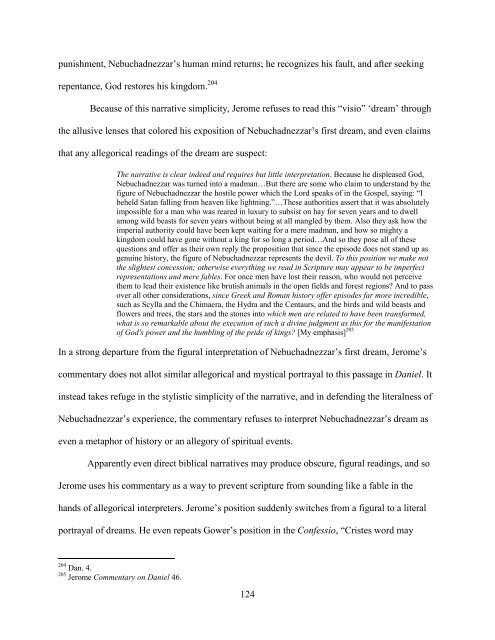WRITING AUTHORITY IN LATE MEDIEVAL ... - Cornell University
WRITING AUTHORITY IN LATE MEDIEVAL ... - Cornell University
WRITING AUTHORITY IN LATE MEDIEVAL ... - Cornell University
Create successful ePaper yourself
Turn your PDF publications into a flip-book with our unique Google optimized e-Paper software.
punishment, Nebuchadnezzar’s human mind returns; he recognizes his fault, and after seeking<br />
repentance, God restores his kingdom. 204<br />
Because of this narrative simplicity, Jerome refuses to read this “visio” ‘dream’ through<br />
the allusive lenses that colored his exposition of Nebuchadnezzar’s first dream, and even claims<br />
that any allegorical readings of the dream are suspect:<br />
The narrative is clear indeed and requires but little interpretation. Because he displeased God,<br />
Nebuchadnezzar was turned into a madman…But there are some who claim to understand by the<br />
figure of Nebuchadnezzar the hostile power which the Lord speaks of in the Gospel, saying: “I<br />
beheld Satan falling from heaven like lightning.”…These authorities assert that it was absolutely<br />
impossible for a man who was reared in luxury to subsist on hay for seven years and to dwell<br />
among wild beasts for seven years without being at all mangled by them. Also they ask how the<br />
imperial authority could have been kept waiting for a mere madman, and how so mighty a<br />
kingdom could have gone without a king for so long a period…And so they pose all of these<br />
questions and offer as their own reply the proposition that since the episode does not stand up as<br />
genuine history, the figure of Nebuchadnezzar represents the devil. To this position we make not<br />
the slightest concession; otherwise everything we read in Scripture may appear to be imperfect<br />
representations and mere fables. For once men have lost their reason, who would not perceive<br />
them to lead their existence like brutish animals in the open fields and forest regions? And to pass<br />
over all other considerations, since Greek and Roman history offer episodes far more incredible,<br />
such as Scylla and the Chimaera, the Hydra and the Centaurs, and the birds and wild beasts and<br />
flowers and trees, the stars and the stones into which men are related to have been transformed,<br />
what is so remarkable about the execution of such a divine judgment as this for the manifestation<br />
of God's power and the humbling of the pride of kings? [My emphasis] 205<br />
In a strong departure from the figural interpretation of Nebuchadnezzar’s first dream, Jerome’s<br />
commentary does not allot similar allegorical and mystical portrayal to this passage in Daniel. It<br />
instead takes refuge in the stylistic simplicity of the narrative, and in defending the literalness of<br />
Nebuchadnezzar’s experience, the commentary refuses to interpret Nebuchadnezzar’s dream as<br />
even a metaphor of history or an allegory of spiritual events.<br />
Apparently even direct biblical narratives may produce obscure, figural readings, and so<br />
Jerome uses his commentary as a way to prevent scripture from sounding like a fable in the<br />
hands of allegorical interpreters. Jerome’s position suddenly switches from a figural to a literal<br />
portrayal of dreams. He even repeats Gower’s position in the Confessio, “Cristes word may<br />
204 Dan. 4.<br />
205 Jerome Commentary on Daniel 46.<br />
124
















